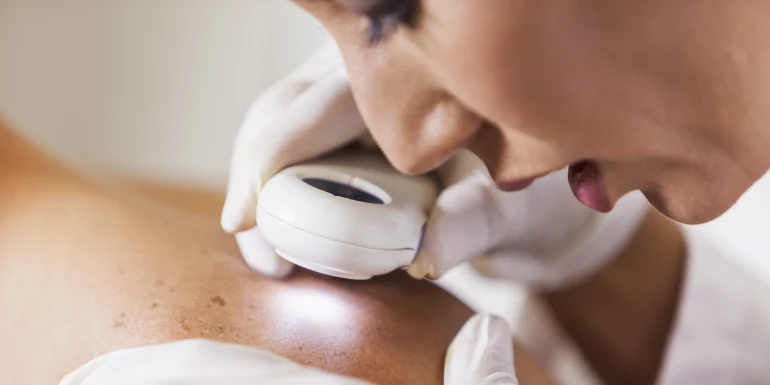
Prevent and remove pigment spots
Skin changes are common and are mostly harmless. Pigment spots have a number of different causes and – if they bother you – can be removed or lightened using various methods and home remedies.
What are pigment spots and are they dangerous?
What actually is the cause of pigment spots? When your skin produces too much melanin, flat spots can appear – these are known as pigment spots and can range in colour from light brown to black. Pigment spots can be caused by sunburn, medication and stress, to name a few.
Hormone changes can also lead to pigment spots, and they often appear during and after pregnancy and when you stop taking the pill. Genetic predispositions and inflammation can also lead to pigment spots. Plus, pigment spots are part of the skin’s normal aging process. Pigment spots are usually harmless and if they appear on your face they may really only bother you for aesthetic reasons. Nevertheless, it is important to keep an eye on pigment spots so that you can spot any changes at an early stage.
Are pigment spots dangerous? Generally speaking, pigment spots are harmless, but in rare cases pigment spots can lead to skin cancer. The difference between pigment spots and skin cancer is found in a change in appearance: if a pigment spot changes its shape, colour or size, you should have it looked at by a dermatologist, just to be on the safe side.
In Switzerland, more than 3,000 people are diagnosed with skin cancer every year. Early detection can save lives. Learn more about this illness in our article.
What types of pigment spots are there?
Pigment spots can appear on various parts of the body. Pigment spots most commonly appear on the face, as well as on the upper lip, the hands and the neckline. Pigment spots mainly differ in their colour:
White or light pigment spots
Light skin discolouration occurs when pigment cells create too little melanin. When large patches of skin turn white, this is known as vitiligo.
Brown and black pigment spots
Age spots are mostly brown, predominantly caused by too much sunlight and mostly harmless.
Red pigment spots
Small raised spots varying from light-red to dark-red in colour are referred to as haemangiomas (or cherry angiomas due to their appearance) and mostly occur on the trunk area (chest, stomach and back); they are not dangerous.
Melasma
This form of pigment spot is isolated to the face, appearing on the forehead, the temples, cheeks or upper lip and mostly affects older women, rarely affecting men. Melasma is most commonly caused by hormones, so pregnant women are often affected by it – it is also referred to as “pregnancy mask”.
Can you prevent pigment spots?
Pigment spots are mostly harmless, if sometimes undesirable. If you want to prevent pigment spots, then you should protect your skin from intense sun exposure. Be sure to use adequate sun protection – including in the winter – and wear a sun hat in the summer.
Tips for preventing pigment spots
How can you treat pigment spots?
There are various remedies and methods for getting rid of pigment spots – or at least making them less visible. Dermatologists will also be able to give you useful information.
Pigment spot cream
Specialist pigment spot creams or pigment spot serums can reduce the appearance of conspicuous pigment spots, but they will not be able to remove them entirely.
Pigment spot laser treatment
Pigment spots and age spots that occur as a result of UV radiation are well suited to laser treatment. This destroys the colour pigments (melanin deposits) in the pigment spots and the colour pigments sheds from the skin. You might be wondering how long it takes for pigment spots to disappear after laser treatment: the healing process usually takes anywhere from a week to 10 days. You should avoid the sun during this time.
Microneedling for pigment spots
Over the past few years, microneedling – also referred to as microdermabrasion – has proven to be an effective method of reducing pigment spots. Microneedling is where the skin is slightly damaged by tiny needles, causing the skin to begin a healing process, so that new cells are created and pigmentation is reduced.
Exfoliation for pigment spots
Conventional exfoliation is ineffective against pigment spots, but it does improve your complexion. Fruit acid peels and chemical exfoliation, on the other hand, can effectively reduce colouration as spots are gently caused to shed.
Remember: even if your GP removes pigment spots for you, the health insurance company will not cover the costs.
Traditional Chinese medicine for pigment spots
Traditional Chinese medicine (TCM) sees pigment spots in women as being caused by a blood deficiency, referred to as “xue xu”, and a subsequent stagnation of the liver that interacts with internal heat. As a result, the skin is not nurtured and dries out. Lifestyle and nutritional changes in combination with TCM herbal therapy are supposed to help.
Home remedies for pigment spots
Home remedies are increasingly recommended for removing bothersome pigment spots. But you should take care because certain natural remedies, such as lemons, can irritate the skin. It is also not a good idea to try to remove pigment spots with baking powder because it has a high pH value and is very alkaline, so applying it directly onto the skin can attack the acid mantle and irritate the skin.
Apple cider vinegar
Apple cider vinegar, on the hand, is harmless. You can treat lighter age spots with a little apple cider vinegar in the morning and in the evening: simply apply a thin layer to the desired area using a cotton pad.
Green tea
Pigment spots can also be treated from the inside out: the phenol contained in green tea is thought to have a positive effect on age spots when consumed on a regular basis.
Aloe vera
Aloe vera has a number of positive qualities. The gel is also effective against pigment spots. Simply apply the gel to the spots and leave for 30 minutes before washing off.
Pigment spots can develop into unaesthetic blemishes. If you would like to avoid this, be sure to use sun protection, follow a balanced diet with enough vitamins and lead a healthy lifestyle. Discolourations cannot be avoided in their entirety but, fortunately enough, pigment spots are mostly harmless. However, it is still worth watching out for changes to pigment spots and having these checked by a doctor if you are ever in doubt.

The expert provided the editorial team with advice and input for this article. Julia Pieh (doctorate in pharmacy and toxicology, pharmacist, naturopath) works in the Helsana Health Consultation Service.


Newsletter
Find out more about current health issues every month and get all the information you need about our attractive offers from all Helsana Group companies * delivered by e-mail to read whenever it suits you. Our newsletter is free of charge and you can sign up here:
We did not receive your information. Please try again later.
* The Helsana Group comprises Helsana Insurance Company Ltd, Helsana Supplementary Insurances Ltd and Helsana Accidents Ltd.